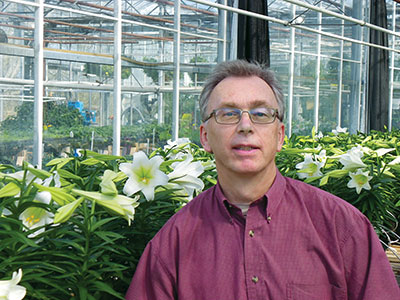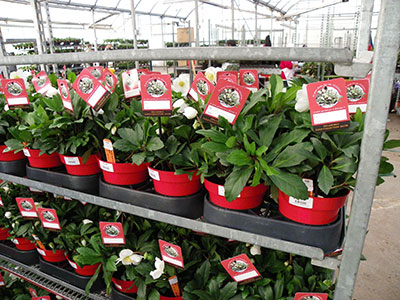
Is branding the answer to boost domestic cut flower production?
Is branding the answer to boost domestic cut flower production?
For growers in California, the answer is “yes.”
 |
|
| Kwantlen instructor Ron Marchuk. PHOTOS COURTESY RON MARCHUK/KWANTLEN UNIVERSITY |
Kasey Cronquist, CEO and ambassador of the California Cut Flower Commission, was the keynote speaker at the recent annual meeting of the Association of Specialty Cut Flower Growers, held in Tacoma, Wash. Some 200 members attended the conference.
Cronquist’s presentation, “Heart and Soil: Reclaiming the American cut flower industry,” reviewed the history of the industry and the impact of South American imports.
The California industry is tackling the challenge head on with its “CA Grown” branding campaign. This program could be a model for other regions working to regain market share. It reminds me of the Pick Ontario program.
The U.S. cut flower industry includes about $400 million of domestic products and $800 million of imports.
Factors helping Colombia’s industry include subsidies, the U.S.–Colombia Free Trade Agreement, and 20 years of U.S. funding to encourage Colombian farmers to replace coca crops with cut flowers.
California exports 25 truckloads of cuts per week, while Colombia and Ecuador ship 35 planeloads each week. One planeload is equal to about 10 to15 truckloads.
More information is available on the commission’s website at www.ccfc.org/americangrown.
The Association of Specialty Cut Flower Growers represents almost 600 field and greenhouse cut flower growers, including 23 Canadian members.
Its annual conference and trade show is held in different cities each year. For the most recent conference, the Pacific Northwest region was chosen as the host, due to its reputation for hot local marketing trends, such as co-operatives, and the natural beauty of Puget Sound and the Cascade Mountains.
The theme that seemed to dominate the talk, both in and outside the seminars, centred on growing local and sustainable cut flowers. Most of the members and attendees embrace and promote this production and marketing approach, normally associated with food crop production.
You’ve heard of the “slow food” movement? Well, here comes “slow flowers!”
Among highlights was a tour of Jello Mold Farm, which sustainably grows 150 varieties on five acres! Tour hosts Dennis Westphall and Diane Szukovathy said their hot sellers include peony, Hypericum, Dahlia ‘Café au Lait,’ and branches of a thornless raspberry ‘Toulamine.’
Westphall showed us an interesting DIY composting system, which combines crop waste, sawdust and salmon waste. The salmon is picked up from a local hatchery or cannery, and then run through a chipper.
Other sessions looked at co-operatives, efforts to market local and sustainably grown flowers, and funding options. The U.S. is way ahead of Canada in terms of national and state farm funding programs, including tax incentives, low-interest loans, the Specialty Crop Block Grant program, and the Value-added Producer Grant program.
Other sessions covered composting and vermicomposting; pest management; post-harvest handling; the Alaskan cut flower peony industry; “sexy niche cut crops” such as Gloriosa lilies, hellebores, hydrangea and herbs; managing crops in high tunnels; and business planning and costing for new growers.
John Dole of North Carolina State University discussed the annual ASCFG cut flower variety trials (www.ncsu.edu/projects/cutflowers), and announced the ASCFG cut flowers of the year for 2013:
- Herbaceous: stock ‘Katz Cherry Blossom.’
- Woody cut: symphoricarpos (snowberry) ‘Amethyst.’
- Bulb winner: ranunculus ‘Super Green.’
The third day featured an all-day bus tour.
The first stop was the Seattle Wholesale Growers’ Market, the first new wholesale flower growers’ market to open in the U.S. in 70 years.
 |
|
| Potted hellebores are becoming a popular Christmas crop in parts of Europe.
|
It was born during a brainstorming session during an ASCFG regional meeting in 2010, and has quickly developed into a thriving growers’ co-operative. It includes 18 flower farms in Washington, Oregon and Alaska. The group is dedicated to revitalizing the Northwest cut flower industry by directly marketing local products to professional floral buyers.
Its mantra is: “Local, organic, sustainable.” It runs three days a week year-round. Fall items we saw included cut flower kale, snowberry, Peterkort roses, lilies, willow, holly wreaths and decorative squash and gourds.
Next we drove north to Mount Vernon and the centre of the Washington bulb industry in the Skagit River valley. We visited Choice Bulb Farm, run by Jan Roozen, an eighth-generation flower grower.
It was then off to the famous Skagit Gardens, with visits to both Skagit sites – one with 10 acres of glass and Cravo greenhouses, and the other with 28 acres of Cravo houses and outdoor production.
We focused on their hellebores program, which they sell as plugs or finished plants to indoor potted plant and cut flower growers, as well as the traditional landscape and garden market.
Keep an eye out for ‘Jacob,’ a beautiful white-flowered cultivar – compact, bushy habit, and tremendous flower count – which looks great in either a 4” or a 6.5” program.
Potted hellebores, it should be noted, are starting to outsell poinsettias as the go-to Christmas crop in parts of Europe.
We ended the tour at Maplehurst Farms for a banquet.
The conference theme of “Learning to Grow Together” was an appropriate choice. This was a gathering of enthusiastic growers, most of them managing small farms by traditional standards. They tend to be young growers, with less than five years’ experience. However, they’re eager to share information, both tips and tribulations, and are keen to help each other – and their industry – grow.
Ron Marchuk is an instructor in the School of Horticulture, Kwantlen Polytechnic University, in Langley, B.C.
Print this page